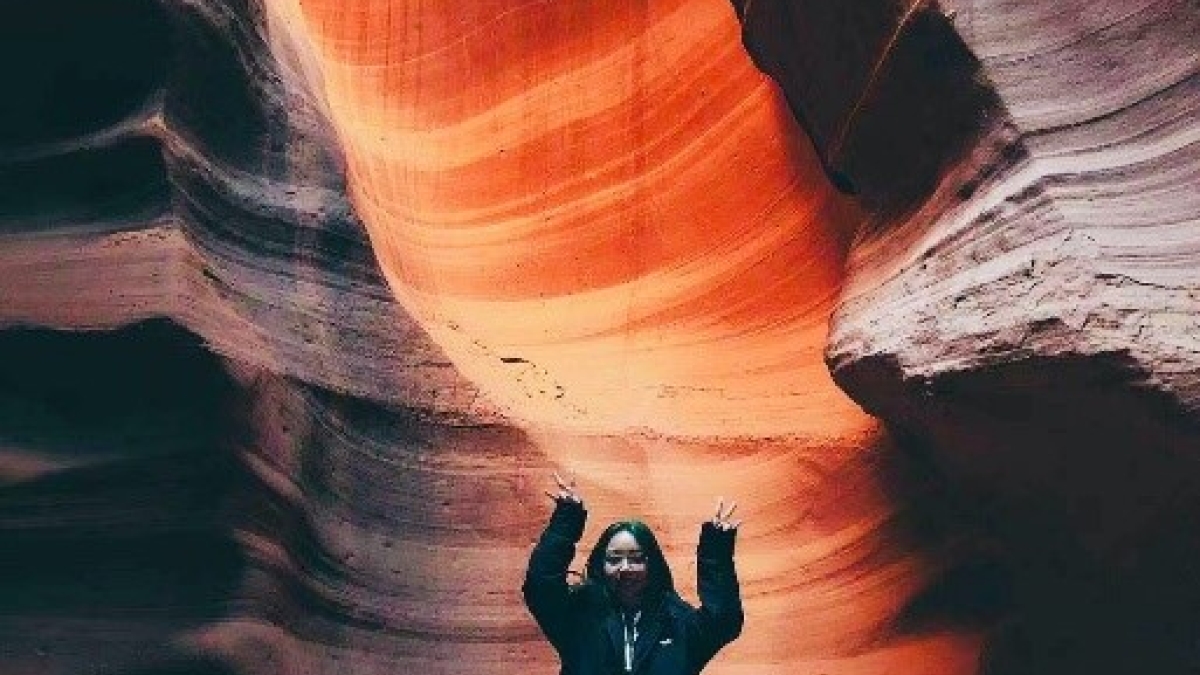ASU tourism students learn how smaller communities deal with large influx of visitors

Jing "Viona" Fang walks through Antelope Canyon near the Arizona-Utah border with about 20 other ASU tourism students in early November to learn about how smaller communities deal with large numbers of visitors. Photo courtesy Claire McWilliams, School of Community Resources and Development
Hiking through hidden caverns bathed with rays of sunlight from above and exploring a traditional Navajo hogan were among the many ways more than 20 Arizona State University tourism students learned of the impacts of tourism in local communities during a recent visit to the windswept rocks and plateaus near Page, Arizona.
The Nov. 1–3 trip offered the students the chance to learn firsthand how social media has driven huge increases in the numbers of visitors at iconic places such as Antelope Canyon and Horseshoe Bend, said Claire McWilliams, tourism development and management instructor and adviser to the ASU Tourism Student Association (TSA).
Tourism development and management major and TSA member Raquel Bigman, a Page resident, assisted the club in creating a learning-intensive itinerary and connecting with key community members.
Upon arriving in Page, on the Utah-Arizona border, the students were taken by guides to Upper Antelope Canyon. Guides described the environmental, cultural and practical value of these locations, as well as the challenges of adapting to visitor totals that have grown exponentially in recent years, McWilliams said.
Navajo tribal members and business owners Tina Mountain, Jazzlyn Begay and Richardson Etsitty shared perspectives about how their community is impacted by tourism and equitable access barriers to resources like water, electricity, funding and permitting.
“I think that this trip was important for us (students) to learn about tourism from a completely different perspective,” said TSA member Jade Gray. “The Navajo, the Native people of this land, are trying to develop their own communities while at the same time welcoming more and more outsiders into their land. It was very humbling.”
TSA member Genna Oppasser agreed.
“What I found of value on this trip was that when a community is involved in tourism there can be heartbreak and pain and joy and pride, all at once. It made me acknowledge the access to resources that I have taken for granted,” she said. “I also see that through my career and how I travel I can help people in places just like this to enjoy more of the benefits of tourism and less of the problematic aspects. I learned you can never truly know until you learn the story of someone who is living it every day."
Students also toured the Antelope Hogan Bed & Breakfast, built and owned by Etsitty, and learned about his approach to offering traditional hogan (pronounced, hoh-GAWN, or hoh-guhn) lodging that looks out onto a stunning vista. Etsitty described his mission to provide his guests with access to authentic storytelling, foods and harmony with the land.
“What I learned from our trip to Page was the word ‘connection.’ I really liked what Jazzlyn, on our panel, said: ‘Culture ... home ... we are tethered to them. When you are far away, their tendrils will pull you back’,” said TSA secretary Shiyu Qiao. “I am from China, and I feel the same way when I am in the United States sometimes. Connection exists between Navajo and nature. Navajo children have nature as their playground. They follow the sunlight as they enter the hogan. There is connection between Navajos and their ancestors all around them. I learned that sustainable tourism development is really important to preserve this."
Big-picture community development is important for students in building their future careers, said Mark Roseland, director of the School of Community Resources and Development at ASU’s Watts College of Public Service and Community Solutions. Roseland reminded the students about how those residents impacted by tourism should properly fit it into the overall plan for raising their quality of life.
Brooks Reece, TSA president, said traveling to Page was the highlight of many educational opportunities gained from TSA membership.
“Learning about the Navajo presented us with the reality that their resources and culture are the central draw to the area, and a challenge: How can tourism models be developed that more equitably and positively impact quality of life for all involved?" Reece said.
“From the Page, Arizona, trip I was able to see such a clear illustration of everything I have been learning about in the tourism development and management program,” said TSA member Paige Corbin. “It was such an amazing opportunity to see how the concepts I learn about in my classes translate into real life. The lessons that I learned on the trip were so powerful and I look forward to being able to share my experiences with others about how to be a conscientious tourist.”
Students also enjoyed Page's annual Balloon Regatta and even helped a balloon crew prepare for launch, enjoying a sense of community resulting from experiences beyond the walls of a classroom.
"I really enjoyed people-watching at Horseshoe Bend from a tourism perspective. It was fascinating — and alarming! — to see how tourists pushed boundaries to take an epic photo,” said TSA member Savannah Stratman. “It was also fun to interact with local vendors at the Balloon Regatta about how many people come into town just for this one event and how much economic impact can result from having the event in their town.”
“Antelope Canyon really hit me! All I could do was surrender to its beauty and touch every line with awe. The workmanship of nature is far beyond human reach,” said Jing ‘Viona’ Fang, a student in Hainan University-Arizona State University Joint International Tourism College in China. “This trip is also the first time I saw stars all over the sky. In my urban city, the sky above is divided by tall buildings. I was so grateful to see the stars shining all over sky — far away from urban areas.”

